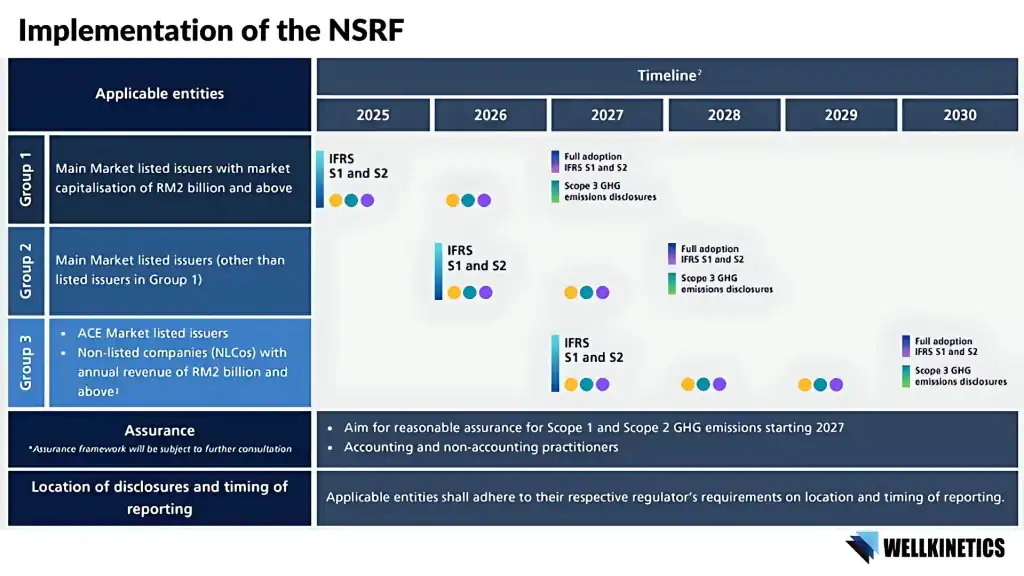A carbon footprint calculation is a method used to quantify the total greenhouse gas emissions generated directly and indirectly by an individual, organization, product, or activity, typically expressed in carbon dioxide equivalents (CO2e). This measurement encompasses all emissions associated with energy usage, transportation, manufacturing processes, waste management, and other relevant activities within a specified time frame.
Carbon footprint calculation in Malaysia is becoming increasingly important as businesses recognize the need to measure and manage their environmental impact. With rising awareness, regulatory expectations, and pressure from stakeholders, calculating and reducing emissions is no longer optional; it’s a strategic necessity.
Are you ready to take control of your company’s environmental impact in Malaysia?
In this comprehensive guide, we’ll walk you through the essential steps to:
- Calculate your company’s carbon emissions across all scopes
- Implement proven reduction strategies tailored for Malaysian businesses
- Meet local regulatory requirements effectively
- Track and report your progress accurately
Whether you’re just starting your sustainability journey or looking to enhance existing practices, this guide provides the expert insights you need to make meaningful environmental changes while maintaining business efficiency.
Get Your Carbon Footprint Assessed Today
Understand your company’s carbon emissions and start taking actionable steps toward reducing them. Let our experts help you calculate and evaluate your current carbon footprint
- What Is a Corporate Carbon Footprint and Why Does It Matter for Businesses?
- What Is the Regulatory Framework for Carbon Emissions Management in Malaysia?
- What Are the Standard Measurement Methodologies for GHG Emissions?
- What Are Carbon Footprint Calculation Tools and How Do They Help Organizations Measure Their GHG Emissions?
- What Are the Emission Sources in Business Operations?
- What Are the Key Strategies for Reducing Carbon Emissions in Business Operations?
- How Can Companies Monitor and Report Their Progress in Reducing Carbon Emissions?
- How Wellkinetics Can Help
What Is a Corporate Carbon Footprint and Why Does It Matter for Businesses?
A corporate carbon footprint represents the total greenhouse gas emissions produced directly and indirectly by a company’s operations. Understanding your business carbon footprint is crucial for implementing effective sustainability strategies and meeting regulatory requirements.
What Are Scope 1 Emissions?
Scope 1 emissions are direct emissions that occur from sources owned or controlled by your company. This includes fuel combustion in company vehicles, manufacturing processes, and on-site energy generation. For instance, if your company operates a fleet of delivery trucks or uses natural gas boilers, the emissions from these activities fall under Scope 1.
What Are Scope 2 Emissions?
Scope 2 emissions represent indirect emissions from purchased electricity, steam, heating, and cooling. When your company buys electricity from the grid, the greenhouse gas emissions associated with generating that electricity are counted as Scope 2. This category is particularly significant for businesses in Malaysia, where electricity generation still heavily relies on fossil fuels.
What Are Scope 3 Emissions?
Scope 3 emissions encompass all other indirect emissions occurring in a company’s value chain. This includes emissions from purchased goods and services, business travel, employee commuting, waste disposal, and the use of sold products. Scope 3 typically accounts for the largest portion of a business carbon footprint, making it crucial for comprehensive emissions reduction strategies.
What Is the Regulatory Framework for Carbon Emissions Management in Malaysia?
Malaysia has committed to achieving net-zero greenhouse gas (GHG) emissions by 2050, aligning with its international obligations under the Paris Agreement. A critical component of this commitment is the implementation of mandatory carbon reporting, ensuring that businesses measure, disclose, and mitigate their environmental impact.
Some key regulatory frameworks in Malaysia are as follows:
1. National Sustainability Reporting Framework (NSRF)

Launched in September 2024, the NSRF mandates that:
- Listed companies on Bursa Malaysia’s Main and ACE Markets disclose Scope 1, 2, and 3 emissions (direct, energy-related, and supply chain emissions, respectively).
- Large non-listed companies (NLCos) with annual revenues exceeding RM2 billion must also comply.
- Scope 3 emissions reporting becomes mandatory in 2027, requiring companies to account for indirect emissions across their value chains.
2. Bursa Malaysia’s Enhanced Reporting Requirements
- Prior to 2023, Bursa Malaysia required PLCs to include Sustainability Statements in annual reports (from around 2016), with voluntary disclosures on emissions if deemed material.
- Under the major enhancement in September 2022, issuers began reporting quantitative Scope 1 and 2 GHG emissions (and limited Scope 3), effective for financial years ending 31 December 2023.
- The latest update came on 23 December 2024, when Bursa amended its Listing Requirements to align fully with Malaysia’s National Sustainability Reporting Framework—mandating adoption of IFRS S1 (general sustainability) and IFRS S2 (climate disclosures) standards on a phased basis: from 1 January 2025 for large Main Market issuers, 2026 for other Main Market, and 2027 for ACE Market entities.
RELATED: Sustainability Reporting Explained: Its Importance & Benefits
3. Environmental Quality Act 1974 & Clean Air Regulations
Under the Environmental Quality Act 1974, Malaysia regulates industrial emissions through the Clean Air Regulations 2014, which impose limits on air pollutants and require monitoring systems for high-emission industries.
To ensure proper adherence to the reporting framework, organizations should:
1. Establish internal monitoring systems
2. Train dedicated environmental compliance officers
3. Maintain up-to-date documentation
4. Engage with certified environmental consultants
5. Participate in industry-specific training programs
RELATED: Sustainability Frameworks: A Guide to Global Standards and Their Application in Malaysia
Ensure Compliance with Malaysian Regulations
Stay ahead of evolving environmental regulations in Malaysia. Get expert advice on how to meet national carbon reporting and reduction requirements.
What Are the Standard Measurement Methodologies for GHG Emissions?
Measurement methodologies refer to the systematic approaches and tools used to quantify greenhouse gas emissions across a company’s operations and value chain. These methodologies provide standardized protocols to ensure consistency and comparability in emissions reporting.
These two are the most widely accepted and used methodologies:
1. The Greenhouse Gas Protocol (GHG Protocol)
- Most widely used international standard
- Provides frameworks for corporate and value chain accounting
- Separates emissions into Scope 1, 2, and 3 categories
2. ISO 14064 Standard
- International standard for GHG quantification and reporting
- Provides principles and requirements for designing and implementing GHG inventories
- Includes verification and validation procedures
Organizations should select methodologies that align with their reporting needs, industry requirements, and stakeholder expectations. The GHG Protocol remains the most commonly adopted framework globally.
How Should Businesses Collect Data for Accurate GHG Emissions Measurement?
The foundation of accurate carbon footprint measurement lies in robust data collection. Following the GHG Protocol standards, companies must systematically gather information from various data sources across their operations. This process involves collecting utility bills, fuel consumption records, and operational data that contribute to emissions.
For comprehensive measurement, organizations should focus on collecting data across all three emission scopes. This includes direct emissions from company-owned facilities, purchased electricity consumption, and indirect emissions from the supply chain. Maintaining detailed records and establishing a standardized collection system ensures data accuracy and consistency.
How Do Businesses Apply Emission Factors to Calculate Their Carbon Footprint?
Once data is collected, the next crucial step is applying the appropriate emission factors. These factors convert activity data into equivalent carbon dioxide emissions. The selection of emission factors must align with recognized standards and regional specifications to ensure accuracy in calculations.
Companies should utilize emission factors from credible sources that are regularly updated to reflect current environmental impacts. The GHG Protocol provides standardized emission factors, but organizations should also consider country-specific factors that account for local energy mix and industrial practices.
The calculation follows a simple formula:
Activity Data × Emission Factor = Carbon Footprint (CO2e)
For example:
Electricity consumption (kWh) × Grid emission factor = CO2 emissions from electricity
Fuel consumption (liters) × Fuel emission factor = CO2 emissions from fuel
What Are Carbon Footprint Calculation Tools and How Do They Help Organizations Measure Their GHG Emissions?
Carbon footprint calculation tools are specialized software or online platforms designed to help organizations measure and analyze their greenhouse gas emissions. These tools typically provide a user-friendly interface for inputting data related to various activities that contribute to carbon emissions, such as energy consumption, transportation, and waste generation.
How Do You Select the Right Carbon Footprint Calculator for Your Business?
When it comes to finding the perfect carbon footprint calculator for your business, several factors deserve careful consideration. A free tool can be an excellent starting point, especially for small and medium-sized enterprises beginning their sustainability journey.
Many organizations start with a basic free tool to understand their emission patterns before investing in more sophisticated solutions. These entry-level calculators can effectively capture essential data while helping companies develop their carbon management strategies. However, to ensure accuracy, align with international standards like the GHG Protocol, and identify reduction opportunities across Scope 1, 2, and 3 emissions, engaging a qualified consultant becomes crucial. A consultant brings technical expertise, industry benchmarks, and the ability to translate data into actionable strategies that support both compliance and long-term sustainability goals.
What Are the Emission Sources in Business Operations?
Emission sources refer to the various activities, processes, or operations within a company’s framework that contribute to greenhouse gas emissions. Understanding these sources is crucial for effective carbon footprint measurement and management.
How Does Energy Consumption Contribute to Carbon Emissions in Business Operations?
In the company’s value chain, energy consumption stands as a primary contributor to carbon emissions. Business facilities rely heavily on electricity for daily operations, lighting, and climate control systems. The use of natural gas for heating and industrial processes also significantly impacts the overall carbon footprint.
Modern office buildings and manufacturing facilities often operate energy-intensive equipment around the clock. From computer servers to production machinery, these operations contribute substantially to the organization’s carbon emissions through both direct energy use and the associated emissions from power generation.
How Does Transportation and Logistics Contribute to Carbon Emissions in Business Operations?
The movement of goods and people represents another significant source of emissions in business operations. Company fleets, employee commuting, and business travel all contribute to the carbon footprint. The transportation of raw materials and finished products through supply chains adds another layer of emissions impact.
Logistics operations, including warehousing and distribution, require substantial energy for temperature control and handling equipment. The choice of transportation modes – whether road, rail, sea, or air – significantly influences the total emissions generated through these activities.
How Does Waste Management Contribute to Greenhouse Gas Emissions in Business Operations?
Improper waste management practices can cause greenhouse gas emissions through various mechanisms. When organic waste decomposes in landfills, it releases methane, a potent greenhouse gas. Additionally, the transportation and processing of waste materials contribute to the overall carbon footprint.
Business operations generate different types of waste, from office paper to industrial byproducts. The way these materials are handled, recycled, or disposed of has direct implications for the company’s environmental impact. Implementing effective waste reduction and recycling programs can significantly lower emissions while potentially reducing operational costs.
What Are the Key Strategies for Reducing Carbon Emissions in Business Operations?
Reduction strategies are systematic approaches adopted by businesses to mitigate their carbon emissions and overall environmental impact. These strategies often focus on enhancing operational efficiency, embracing sustainable practices, and utilizing innovative technologies. Implementing effective reduction strategies is vital for companies aiming to achieve their sustainability goals while also managing costs and resources efficiently.
What Are Some Effective Short-Term Actions for Reducing Carbon Emissions in Business Operations?
Addressing climate change requires immediate action to reduce your company’s carbon footprint. Start by implementing energy-efficient lighting systems and smart thermostats throughout your facilities. These simple changes can lead to significant reductions in energy consumption and associated emissions.
Encourage employees to adopt sustainable practices like reducing paper usage, implementing recycling programs, and promoting digital documentation. Consider introducing remote work policies where feasible, which can substantially decrease commuting-related emissions contributing to global warming.
Conduct regular energy audits to identify areas of excessive consumption and implement quick fixes. This might include sealing air leaks, maintaining HVAC systems, and upgrading to energy-efficient office equipment. Train your staff on energy-saving practices and create awareness about their role in reducing the company’s environmental impact.
What Are the Key Long-Term Planning Strategies for Reducing Carbon Emissions in Business Operations?
Developing a comprehensive sustainability strategy is crucial for lasting impact on your carbon footprint. Consider investing in renewable energy sources like solar panels or wind power to reduce dependence on fossil fuels. This not only helps combat climate change but also provides long-term cost savings.
Evaluate your supply chain and partner with environmentally conscious suppliers who share your commitment to sustainability. Consider implementing a green procurement policy that prioritizes eco-friendly products and services. This systematic approach ensures your company’s contribution to fighting global warming extends beyond immediate operations.
Focus on building design and infrastructure improvements that promote energy efficiency. This might include installing better insulation, implementing green building standards, or redesigning spaces to maximize natural light. Consider investing in electric vehicle charging stations and encouraging sustainable transportation options among employees.
Develop a monitoring system to track progress and adjust strategies as needed. Regular assessment helps ensure your reduction efforts remain effective and aligned with your sustainability goals.
RELATED: Offsetting CO2: How to Effectively Reduce Your Carbon Footprint with Carbon Offsets in Malaysia
Implement Carbon Reduction Strategies
Whether for the short term or long term, Wellkinetics has the expertise to help your business reduce carbon emissions effectively.
How Can Companies Monitor and Report Their Progress in Reducing Carbon Emissions?
Monitoring and reporting progress refer to the systematic process of tracking a company’s environmental impact and measuring the effectiveness of its sustainability initiatives. This involves collecting data on various metrics, such as energy consumption, emissions levels, waste generation, and resource utilization. By regularly analyzing this information, businesses can identify trends, assess the success of implemented strategies, and make informed decisions for future improvements.
How Can Companies Effectively Track Their Carbon Reduction Progress?
Effective monitoring and reporting of your company’s carbon footprint reduction efforts is crucial for long-term success. Regular tracking helps identify areas of improvement and ensures your sustainability initiatives remain on course.
To maintain accurate records, implement a systematic approach to data collection across all emission sources. This provides useful information about your progress and helps identify potential areas for optimization. Consider using specialized software or spreadsheets to track:
- Energy consumption patterns
- Transportation emissions
- Waste management metrics
- Supply chain carbon outputs
- Equipment efficiency rates
Organizations often face various challenges when monitoring their carbon reduction progress. Common obstacles include:
- Inconsistent data collection methods
- Limited access to accurate emission factors
- Resource constraints for regular monitoring
- Difficulty in coordinating across departments
- Complex reporting requirements
To address these challenges, implement clear protocols for data collection and reporting. Train team members on proper documentation practices and use standardized templates to ensure consistency. Conduct regular audits to verify data accuracy, identify gaps, and maintain the integrity of your reporting process.
Consider implementing a dashboard system that visualizes your progress toward carbon reduction goals. This can help:
- Track real-time performance metrics
- Compare results against benchmarks
- Identify trends and patterns
- Generate automated reports
- Share progress with stakeholders
Remember to regularly communicate progress updates to all relevant stakeholders, including employees, management, and external partners. This transparency helps maintain accountability and demonstrates your commitment to sustainability goals.
Engaging a consultant can further strengthen this effort by providing expert guidance on setting up robust systems, validating methodologies, and ensuring alignment with regulatory and international reporting standards such as the GHG Protocol.
How Wellkinetics Can Help
At Wellkinetics, we understand that navigating the complexities of sustainability and carbon footprint reduction can be challenging for businesses. Our expertise lies in providing tailored solutions that empower organizations to take meaningful action towards environmental responsibility. Here’s how we can support your journey toward sustainability:
1. Comprehensive Assessment Services
We offer detailed carbon footprint assessments that consider all aspects of your operations. Our experts will help you understand your current emissions, identify key areas for improvement, and establish benchmarks to measure progress over time.
2. Customized Reduction Strategies
With our deep knowledge of industry best practices, we work closely with you to develop and implement targeted reduction strategies that align with your business goals. Whether it’s optimizing energy consumption, improving waste management, or enhancing transportation logistics, we tailor strategies that fit your specific needs.
3. Monitoring and Reporting Solutions
We provide cutting-edge monitoring tools that streamline data collection and reporting processes. Our user-friendly dashboards allow you to visualize your sustainability metrics in real-time, making it easier to track progress, identify trends, and communicate results to stakeholders efficiently.
4. Training and Support
Our team offers training sessions and resources for your employees to instill a culture of sustainability within your organization. By equipping your team with the knowledge and tools they need, you can ensure that your sustainability initiatives are embraced at all levels.
5. Compliance Guidance
Navigating local and international regulations can be daunting. Our compliance guidance services will help you understand and adhere to local regulations in Malaysia and international standards. We ensure that your sustainability efforts meet necessary legal requirements, minimizing the risk of penalties and enhancing your reputation among regulators and stakeholders alike.
6. Ongoing Support and Advisory
Sustainability is an evolving field, and we are committed to being your partner throughout this journey. Our ongoing support includes regular check-ins, updates on new regulations, and continuous improvement recommendations. We aim to build a long-term relationship that fosters knowledge transfer and empowers your organization to stay at the forefront of sustainability practices.
Learn more about our ESG consulting services and environmental consulting services.




